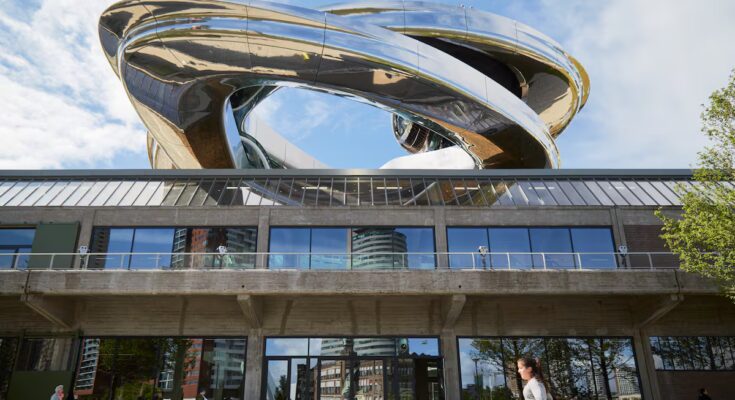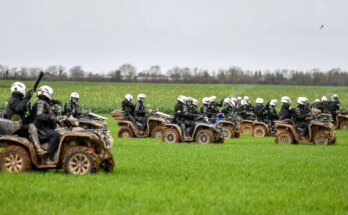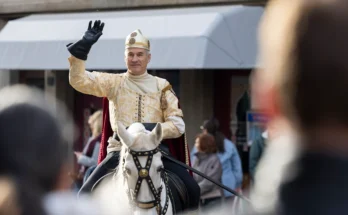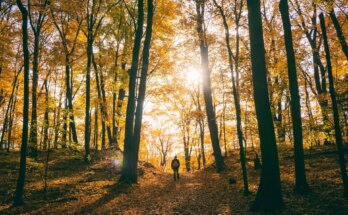Migration has four parts: the march, the journey, the arrival and the settlement. Good or bad luck is what motivates this movement, which, in reality, is a search: for adventures, reunions, security and/or new opportunities. Migration is a journey for which there is not always time to pack. Those who migrate and their loved ones say goodbye without knowing when they will see each other again. That is, the loneliness of the migrant settled in a geography that is not his. Rotterdam is one of those geographies. Many people boarded ships docked in its port bound for the United States and Canada in the early to mid-20th century. Although earlier, in 1620, the Pilgrim Fathers William and Dorothy Bradford did it on their ship Veronica from the pier in the Delfshaven district bound for America.
While some departed far from Europe, others disembarked in the port of Rotterdam from Greece, Cape Verde, Suriname, Indonesia, China… The first to arrive settled on the Katendrecht peninsula, between the river ports Rijn and Maas, where the ship remains anchored. SS Rotterdamflagship of the Holland-America Line company. A steamship known as The Great Lady for its 228 meters long, 28 wide and 51 high, which operated as a cruise ship on the Rotterdam-New York route from 1959 to 1988 and which has currently been transformed into a floating hotel.
Katendrecht is a port area popularly known as “De Kaap” (The Cape) and for a time was home to the largest Chinatown in Europe. A dock workers’ strike in 1911 forced local authorities to bring in Chinese sailors who were in London to continue work on the docks. Over time, the site’s streets filled with Chinese restaurants, such as Chong Kok Low, which was the first to open in 1920, as well as shops, guesthouses, laundries, and opium dens. Activities all frequented by men, who were the first to settle. A Chinese neighborhood to which other nationalities and brothels have been added, making the site a typical red light district of a port city.
In Katendrecht there are two converted former warehouses: the Fenix Food Factory, a gastronomic market with restaurants, bars and design shops, and the Fenix Museum, a space of dialogue between migration, art and architecture, on the banks of the New Meuse river. An initiative of Droom en Daad, a foundation in which the descendants of the Holland-America Line company are present and which aims to help redefine what Rotterdam is in the 21st century. The museum, inaugurated last May, consists of several exhibitions, all linked to displacement, migration, forced travel, through the gaze of international artists, such as Shilpa Gupta, Steve McQueen, Rineke Dijkstra and Kimsooja.
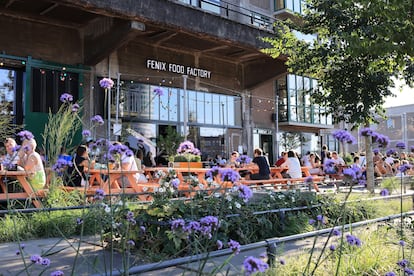
More than 170 nationalities coexist in Rotterdam, not counting those from unrecognized countries, such as Palestinians, Tibetans and Uyghurs. For dialogues and connections between people of different cultures, those established thanks to the work carried out by the operators of the Belvedere House of Stories, in Katendrecht.
Anja Brand, tour guide and worker at the aforementioned House of Stories, mentions The Traveler at Deliplein. A pleasant tree-lined triangular square, manned by several world cuisine restaurants with views of the Fenix Food Factory and the Fenix Museum. The woman is a widow, she was married to a man originally from Suriname and from that relationship her two daughters were born. He says that residents of the neighborhood strongly opposed the idea of building apartments above the museum, as they were built above the market, because if they did the Deliplein would be deprived of the sun’s rays.

Its designer, Ma Yansong of MAD Architects, the first Chinese architect to design a museum in Europe, was inspired by the site’s status as a port of departure and arrival. The tornado This is what the most visible architectural element of the building is called, it is a sculpture and an observation platform which is accessed via a double spiral staircase with wooden floor and stainless steel walls. That swirling appearance makes the tornado appear to be moving forward. This movement is a tribute to all the movements that occurred in the port of Rotterdam.
Not only have people moved, but also goods. Hence the warehouses that were on the quay and which today are this market and this museum. Initially it was a single 360 meter long warehouse built in 1923 and owned by the Holland-America Line company. It was known as the San Francisco warehouse. During World War II, Nazi Germany troops severely damaged some parts and a fire destroyed it in 1948. Like the Phoenix, it rose from its ashes transformed into two warehouses called Fenix I and Fenix II. As time passed the ships became larger. So much so that they did not enter the docks in this part of the port, which meant that warehouses and buildings remained empty and Katendrecht became a sort of ghost town isolated from the rest of Rotterdam.
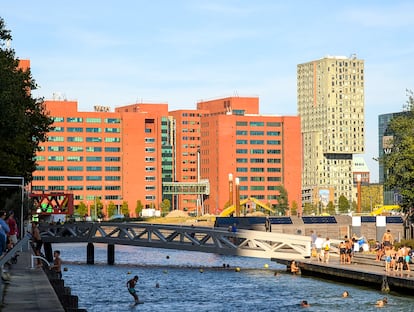
In 2012, a bridge was built that was as controversial, due to the image of the red light district of Katendrecht, as it was necessary, due to the turn that had to be taken to get from one bank to the other. In the end, residents on both sides of the port of Rijn benefited. The bridge in question connects the currently highly sought-after neighborhoods of Katendrecht and Wilhelminapier, part of the Kop van Zuid, where the Cruise Terminal, the Rotterdam skyscraper and the Hotel New York are located. This historic arrangement motivated the creation of the Water Taxi to provide a service to its guests, who were passengers on ships sailing to America and Canada (today it is another form of public transportation and a fun way to see the city from the water).

That connection to North America can be felt by walking and looking up. The tip of the Wilhelminapier peninsula is a sort of Manhattan of the Meuse River. Next to the water taxi headquarters there is a bathing area in the port of Rijn. In the same water float offices and cabins of Wikkelboats, which can be rented.
Anja’s tour to Katendrecht includes several stops; a souvenir and photography shop; Café Norge, bar and meeting point of the neighborhood; and a community center that helps undocumented migrants enter Dutch society by providing accommodation, for a certain period, and helping them look for work. It occupies an old sailors’ church. The center seeks to build community. While walking from place to place, Anja tells many stories of some neighbors who came from far away. There were soldiers, musicians, business owners, mixed-race couples, white widows left alone to run the house, and children who weren’t white, etc. It says that all people are connected. That we are all migrants.
travel notebook
- How to go to Rotterdam. By plane with KLM, Iberia, Iberia Express and Air Europa to Schiphol. At the same airport you can take a direct train to Rotterdam. To purchase train tickets you can use the site ns.nl/en.
- Where to sleep. Very close to Rotterdam Central Station there is a hostel of the A&O chain. It has rooms with multiple beds, perfect for groups and limited budgets. It also has double, triple and quadruple rooms, with private bathroom. It has a garage and a bicycle rental service, the best means of transport for getting around the city. The SS Rotterdam, the same ship that traveled the Rotterdam – New York route until the mid-20th century, is today a hotel anchored in the Katendrecht district. There is a limited shuttle service available for guests from Rijnhaven metro station. The ship can be seen by taking one of the available guided tours. It is a hotel and a floating museum. The cabins are spacious, with bathroom included. It has several restaurants and bars, one of them with a small pool on one of the decks.
- Where to eat. Far from the city center, but in a lively area, is Station Bergweg, an old train station transformed into a large dining hall where you can find several food and drink stands: sushi, burgers, pizzas, oysters, mussels, tacos, etc. On the upper floor, where the tracks once stood, there is now a bar and in good weather a summer cinema is installed. In the Fenix Museum there is the Turkish cuisine restaurant O. In Deliplein, next to the same museum, there are several restaurants with terraces. In the Verhalenhuis Belvédère (The House of Stories), a historic building from 1894, is a café and restaurant. Every day there is a chef of one nationality and prepares dishes from his country. They have been open since 2008. It consists of several floors, where exhibitions, workshops, concerts and other activities take place.
